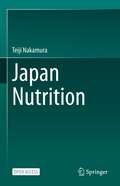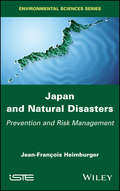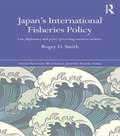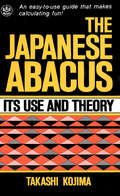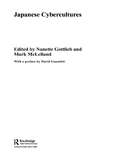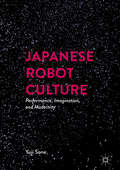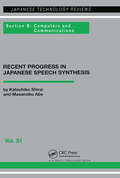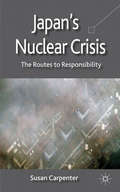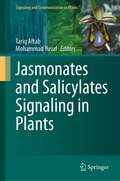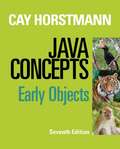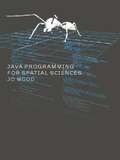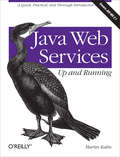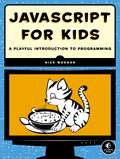- Table View
- List View
Japan Nutrition
by Teiji NakamuraThis Open Access auto-translation book demonstrates a time series of nutrition improvement in Japan since the introduction of nutrition sciences to Japan about 150 years ago. The chapters present the historical event where nutritional deficiency due to food shortage was improved in almost a century, by the introduction of nutrition policy and practices such as the "Nutrition Improvement Law". The book contributed to the construction of a longevity nation by resolving the double burden of malnutrition, which is a mixture of undernutrition and overnutrition and creating a social environment in which sustainable healthy diets can be accessed.This publication is designed mainly for nutrition specialists, nutritionists, nutrition administrators, medical doctors, pharmacists, nurses, physiotherapists, nutrition educators, cookers, nutrition volunteers, health and nutrition food developers, school lunch managers, and etc. Furthermore, students studying nutrition, teachers involved in the education and training of dietitians, and general consumers who are interested in nutrition, diets, and how to improve malnutrition, will find this book useful.Through this book, dietitians, nutrition volunteers, and consumers engaged in nutrition improvement can understand the significance of nutrition improvement and know specific methods. Young nutritionists who will study and research nutrition can learn the importance of nutrition and take pride in nutrition research. The government official who implements nutrition policy can know the concrete method of nutrition policy.Today, people around the world understand the importance of nutrition and are gaining international interest. However, malnutrition has not improved as much as expected. This book is an interesting way for everyone involved in nutrition to learn how to eradicate malnutrition from the world. The translation was done with the help of artificial intelligence (machine translation by the service DeepL.com). The present version has been revised technically and linguistically by the author in collaboration with Professor Emeritus Dr. Andrew R. Durkin of Indiana University.
Japan and Natural Disasters: Prevention and Risk Management
by Jean-Francois HeimburgerJapan is one of those countries most often affected by powerful natural hazards: earthquakes, tsunamis, volcanic eruptions, typhoons, heavy rains, heavy snowfall, tornadoes, etc. The Archipelago is considered a very advanced country in terms of forecasting, prevention and management of natural disasters. A detailed analysis of the reality of recent years is however necessary. In the run-up to the 2020 Olympic Games in Tokyo, among others, a publication on the subject will inform a large number of people wanting to know more about the risks of natural disasters in Japan.
Japan's Agricultural Policy Regime (Nissan Institute/Routledge Japanese Studies)
by Aurelia George MulganWritten by the world’s leading expert in the field, this book examines the evolution of Japanese agricultural policy in the post-war period, focusing particularly from the 1970s onwards when both domestic and external pressures for reform began to intensify. The author explains how the MAFF has safeguarded their institutional capacity to intervene by accommodating both public interest in agricultural policy reform alongside the interests of government in maintaining agricultural support and protection. The book provides a major reinterpretation of agricultural policy, examining how the MAFF’s role as an ‘intervention maximiser’ has been redefined in the face of continued bureaucratic involvement. Making available in English for the first time Japanese policy changes in the post-war period, the book will appeal to political economy specialists and political scientists, and those with an interest in Japanese politics and bureaucratic institutions.
Japan's International Fisheries Policy: Law, Diplomacy and Politics Governing Resource Security (Nissan Institute/Routledge Japanese Studies)
by Roger D. SmithFew nations rely upon the ocean as much as Japan for livelihood, culture and transport. The seas have long played a vital role for the Japanese, helping to support the economic and social life of a nation that possesses few resources and little arable land, and sustain a population that has nearly tripled in the last century. Fish are a distinctive feature of the Japanese diet, constituting nearly half of all animal protein consumed – the highest rate in the world. The industry itself has provided an impetus for coastal community growth and national economic development over the past century, while fisheries have worked their way into Japanese culture and customs, serving as a dominant symbol in traditional arts and folklore. This book explores the overarching rationale that motivated Japanese international fisheries policy throughout the post-war period until today, highlighting the importance of international fisheries to Japan and the stature this resource has occupied as a national interest. It provides a comparative view of Japanese foreign policy at various ocean conferences, treaty negotiations, bilateral diplomatic initiatives and other maritime relations that constitute ocean policy over half a century, and investigates the domestic constituents of national policy. Roger Smith argues that the rationale for international fisheries policy may be best viewed as deriving from Japan’s unique defence strategy for its national interests: comprehensive security. Encompassing non-military elements and most importantly defence of economic interests, Japan’s international fisheries policy provides an interesting case study of how comprehensive security is conceptualised and carried out. Taking a broad view of Japan’s international fisheries policies from 1945 to the present, this book highlights the key trends in policy motives and means throughout the post-war period. As such, it will be of great interest to students and scholars of Japanese studies, international and environmental law, resource management and international relations, as well as to policy makers working in the field.
Japan's Nuclear Disaster and the Politics of Safety Governance
by Florentine KoppenborgIn Japan's Nuclear Disaster and the Politics of Safety Governance, Florentine Koppenborg argues that the regulatory reforms taken up in the wake of the Fukushima disaster on March 11, 2011, directly and indirectly raised the costs of nuclear power in Japan. The Nuclear Regulation Authority resisted capture by the nuclear industry and fundamentally altered the environment for nuclear policy implementation. Independent safety regulation changed state-business relations in the nuclear power domain from regulatory capture to top-down safety regulation, which raised technical safety costs for electric utilities. Furthermore, the safety agency's extended emergency preparedness regulations expanded the allegorical backyard of NIMBY demonstrations. Antinuclear protests, mainly lawsuits challenging restarts, incurred additional social acceptance costs. Increasing costs undermined pronuclear actors' ability to implement nuclear power policy and caused a rift inside the "nuclear village." Small nuclear safety administration reforms were, in fact, game changers for nuclear power politics in Japan. Koppenborg's findings contribute to the vibrant conversations about the rise of independent regulatory agencies, crisis as a mechanism for change, and the role of nuclear power amid global interest in decarbonizing our energy supply.
Japanese Abacus Use & Theory
by Takashi KojimaThe Japanese Abacus & Theory book is easy to follow, and gives the reader step-by-step directions on how to use it correctly while applying it to practical use. The imperfect numerical notation and scarcity of suitable writing materials in ancient times are presumed to have given rise to need for devices of mechanical calculation. While the definite origin of the abacus is obscure, there is some reason for believing that its earliest form reckoning table covered with sand or fine dust, in which figures were drawn with a stylus, to be erased with the figure when necessary. Though the Abacus is an older tool for calculation it still is used today in Japan taking on a different name called Soroban. Though the Japanese Abacus or Soroban may appear mysterious or even primitive to those raised in the age of pocket calculators and desktop computers, this intriguing tool is capable of amazing speed and accuracy. It is still widely used throughout the shops and markets of Asia, and its popularity shows no sign of decline. Here for the first time in English is a complete explanation of how to use the abacus.
Japanese Contractors in Overseas Markets: Bridging Cultural and Communication Gaps (Management in the Built Environment)
by Kazuhito Suzuki Low Sui PhengThis book explores the differences in cultural attributes and management factors to enable managers working for Japanese contractors to reduce misunderstandings and misinterpretations when communicating with project team members from different cultural backgrounds. It focuses on Japanese contractors operating in Singapore, since the Singapore construction industry has, for many years, been one of the largest overseas construction markets for the top-5 Japanese contractors. Using Hofstede’s national cultural framework for the cultural studies in construction project management, it reveals various real-world management practices and discusses national cultural differences relating to managers working for Japanese contractors in Singapore as well as the communication weaknesses of current management practices and styles. The results presented provide useful lessons for Japanese contractors operating in Singapore, as well as other parts of the world, to bridge cultural and communication gaps.
Japanese Cybercultures (Asia's Transformations/Asia.com)
by Nanette Gottlieb Mark McLellandJapan is rightly regarded as one of the most technologically advanced countries in the world, yet the development and deployment of Internet technology in Japan has taken a different trajectory compared with Western nations. This is the first book to look at the specific dynamics of Japanese Internet use. It examines the crucial questions:* how the Japanese are using the Internet: from the prevalence of access via portable devices, to the fashion culture of mobile phones* how Japan's "cute culture" has colonized cyberspace* the role of the Internet in different musical subcultures* how different men's and women's groups have embraced technology to highlight problems of harassment and bullying* the social, cultural and political impacts of the Internet on Japanese society* how marginalized groups in Japanese society - gay men, those living with AIDS, members of new religious groups and Japan's hereditary sub-caste, the Burakumin - are challenging the mainstream by using the Internet.Examined from a variety of interdisciplinary perspectives, using a broad range of case-studies, this is an exciting and genuinely cutting-edge book which breaks new ground in Japanese studies and will be of value to anyone interested in Japanese culture, the Internet and cyberculture.
Japanese Robot Culture
by Yuji SoneJapanese Robot Culture examines social robots in Japan, those in public, domestic, and artistic contexts. Unlike other studies, this book sees the robot in relation to Japanese popular culture, and argues that the Japanese 'affinity' for robots is the outcome of a complex loop of representation and social expectation in the context of Japan's continuing struggle with modernity. Considering Japanese robot culture from the critical perspectives afforded by theatre and performance studies, this book is concerned with representations of robots and their inclusion in social and cultural contexts, which science and engineering studies do not address. The robot as a performing object generates meaning in staged events and situations that make sense for its Japanese observers and participants. This book examines how specific modes of encounter with robots in carefully constructed mises en sc#65533;ne can trigger reflexive, culturally specific, and often ideologically-inflected responses.
Japanese Speech Synthesis
by Jeffry H. ShiraiAn introduction to recent results of Japanese research and development in the fields of speech synthesis.
Japanese Telecommunications: Market and Policy in Transition (Routledge Studies in the Growth Economies of Asia)
by Ruth Taplin Masako WakuiPresenting a comprehensive survey of the telecommunications industry in Japan, Taplin and Wakui cover the different sectors of the industry – including mobile, broadband and satellite, whilst considering key questions such as the structure and economics of the industry, government policy, and international relations issues connected to the industry. The volume brings together unique analysis by renowned experts in the telecommunications field. One major overall problem is that, unlike many other industries, Japan has lagged behind other countries in telecommunications. Japanese Telecommunications considers why this should be so, showing how far this is attributable to an unmodernized industry structure, and assessing the measures being taken to address the problem. After over a decade of struggle, Japan has recorded rapid uptake of broadband, and Japanese advanced mobile services have become increasingly successful on a global scale. Japan has also undergone regulatory reform, and competition policy is now given top priority by government. Taplin and Wakui examine the most recent developments and provide signposts for the future.
Japanese Women Writers: Twentieth Century Short Fiction (Japan In The Modern World Ser.)
by Kyoko Iriye Selden Noriko Mizuta Lippit"Here are Japanese women in infinite and fascinating variety -- ardent lovers, lonely single women, political activists, betrayed wives, loyal wives, protective mothers, embittered mothers, devoted daughters. ... a new sense of the richness of Japanese women's experience, a new appreciation for feelings too long submerged". -- The New York Times Book Review
Japan’s Nuclear Crisis
by Susan CarpenterAn analysis and exploration into the impact of Japan's 2011 nuclear crisis. Investigation of the disaster will pose questions regarding why Daiichi was constructed in an earthquake-prone zone and was still operating despite problems that had been plaguing the reactors since 1989 such as cracks in infrastructure and leaks in radioactivity.
Jasmonates and Salicylates Signaling in Plants (Signaling and Communication in Plants)
by Tariq Aftab Mohammad YusufDemand for agricultural crops and nutritional requirement continues to escalate in response to increasing population. Also, climate change exerts adverse effects on agriculture crop productivity. Plant researchers have, therefore, focused to identify the scientific approaches that minimize the negative impacts of climate change on agricultural crops. Thus, it is the need of the hour to expedite the process for improving stress tolerance mechanisms in agricultural crops against various environmental factors, in order to fulfil the world’s food demand. Among the various applied approaches, the application of phytohormones has gained significant attention in inducing stress tolerance mechanisms.Jasmonates are phytohormones with ubiquitous distribution among plants and generally considered to modulate many physiological events in higher plants such as defence responses, flowering and senescence. Also, jasmonates mediate plant responses to many biotic and abiotic stresses by triggering a transcriptional reprogramming that allows cells to cope with pathogens and stresses. Likewise, salicylates are important signal molecules for modulating plant responses to environmental stresses. Salicylic acid influences a range of diverse processes in plants, including seed germination, stomatal closure, ion uptake and transport, membrane permeability and photosynthetic and growth rate.Understanding the significant roles of these phytohormones in plant biology and from agriculture point of view, the current subject has recently attracted the attention of scientists from across the globe. Therefore, we bring forth a comprehensive book “Jasmonates and Salicylates Signalling in Plants” highlighting the various prospects involved in the current scenario. The book comprises chapters from diverse areas dealing with biotechnology, molecular biology, proteomics, genomics, metabolomics, etc. We are hopeful that this comprehensive book furnishes the requisite of all those who are working or have interest in this topic.
Jatropha curcas L: Agronomy, Biotechnology, Biodiesel and Byproducts (Environmental Science and Engineering)
by Kamrun NaharThis book addresses the opportunity to cultivate a multipurpose, drought resistant and nonfood bioenergy crop, Jatropha curcas L. in Bangladesh. As a renewable resource and a sustainable substitute for fossil fuel, Jatropha curcas produces seeds containing inedible oil, which can supply fuel and meet the national energy demands of Bangladesh. The plant does not need arable lands and does not compete with food, water and nutrients. This book also highlights the land use patterns and possible cultivation areas of Bangladesh. It is based on research of the cultivation technology, ecological and agronomical aspects, biotechnological methodologies, harvesting and crop yield including fuel and byproduct formation. It also highlights the different uses and socioeconomic benefits of the plant and production costs and briefly describes the procedure for the production of biodiesel and other useful byproducts. The comparison of biodiesel from Jatropha curcas with conventional fossil fuel is also discussed as well as its ability to sequester carbon from the environment to cope up with climate change, adaptation as well as mitigation
Java Concepts: Early Objects
by Cay S. HorstmannIn Java Concepts, Cay Horstmann provides a comprehensive introduction to fundamental programming techniques and design skills helping the student master basic concepts. Realistic programming examples, homework assignments, and lab exercises build student problem-solving abilities.
Java Message Service
by Richard Monson-Haefel Dave ChappellThis book is a thorough introduction to Java Message Service (JMS) from Sun Microsystems. It shows how to build applications using the point-to-point and publish-and-subscribe models; use features like transactions and durable subscriptions to make applications reliable; and use messaging within Enterprise JavaBeans. It also introduces a new EJB type, the MessageDrivenBean, that is part of EJB 2.0, and discusses integration of messaging into J2EE.
Java Message Service: Creating Distributed Enterprise Applications
by Richard Monson-Haefel David A Chappell Mark RichardsJava Message Service, Second Edition, is a thorough introduction to the standard API that supports "messaging" -- the software-to-software exchange of crucial data among network computers. You'll learn how JMS can help you solve many architectural challenges, such as integrating dissimilar systems and applications, increasing scalability, eliminating system bottlenecks, supporting concurrent processing, and promoting flexibility and agility.Updated for JMS 1.1, this second edition also explains how this vendor-agnostic specification will help you write messaging-based applications using IBM's MQ, Progress Software's SonicMQ, ActiveMQ, and many other proprietary messaging services.With Java Message Service, you will:Build applications using point-to-point and publish-and-subscribe messaging modelsUse features such as transactions and durable subscriptions to make an application reliableImplement messaging within Enterprise JavaBeans (EJB) using message-driven beansUse JMS with RESTful applications and with the Spring application frameworkMessaging is a powerful paradigm that makes it easier to uncouple different parts of an enterprise application. Java Message Service, Second Edition, will quickly teach you how to use the key technology that lies behind it.
Java Programming for Engineers
by Julio Sanchez Maria P. CantonWhile teaching Java programming at Minnesota State University, the authors noticed that engineering students were enrolling in Java programming courses in order to obtain basic programming skills, but there were no Java books suitable for courses intended for engineers. They realized the need for a comprehensive Java programming tutorial that offer
Java Programming for Spatial Sciences
by Jo WoodThe Java programming language has been one of the most exciting internet-friendly technologies to emerge in the last decade. Java Programming for Spatial Sciences introduces the subject to those who wish to use computers to handle information with a geographical element.The book introduces object-oriented modeling including key concepts suc
Java Web Services: Up and Running
by Martin KalinThis example-driven book offers a thorough introduction to Java's APIs for XML Web Services (JAX-WS) and RESTful Web Services (JAX-RS). Java Web Services: Up and Running takes a clear, pragmatic approach to these technologies by providing a mix of architectural overview, complete working code examples, and short yet precise instructions for compiling, deploying, and executing an application. You'll learn how to write web services from scratch and integrate existing services into your Java applications. With Java Web Services: Up and Running, you will:Understand the distinction between SOAP-based and REST-style servicesWrite, deploy, and consume SOAP-based services in core JavaUnderstand the Web Service Definition Language (WSDL) service contractRecognize the structure of a SOAP messageLearn how to deliver Java-based RESTful web services and consume commercial RESTful servicesKnow security requirements for SOAP- and REST-based web servicesLearn how to implement JAX-WS in various application serversIdeal for students as well as experienced programmers, Java Web Services: Up and Running is the concise guide you need to start working with these technologies right away.
Java in 14 Wochen: Ein Lehrbuch für Studierende der Wirtschaftsinformatik
by Kaspar RiesenDieses Buch ist der ideale Begleiter, wenn Sie in einem Semester Java lernen möchten. Der Inhalt wurde gezielt ausgewählt, so dass nur die Konzepte besprochen werden, die Sie zum Einstieg in die Programmierung wirklich benötigen. Diese Konzepte werden mit zahlreichen, anschaulichen Beispielen illustriert. Weiter wird im Buch ein durchgehendes Beispielprojekt in Java, das von Kapitel zu Kapitel wächst, entwickelt. Zu jedem Kapitel finden sich zudem viele Aufgaben zur Selbstkontrolle und Programmierübungen in Java. Zu jeder Übung ist ein Lernvideo verlinkt, auf dem der Autor des Buches die Übung vorprogrammiert. Das Buch ist somit optimal geeignet für Studierende der Wirtschaftsinformatik, Informatik oder anderer Fachrichtungen sowie für alle Interessierten, die ohne Vorkenntnisse Programmieren lernen möchten.
Java in a Nutshell: A Desktop Quick Reference (Seventh Edition) (In a Nutshell)
by David Flanagan Ben Evans<p>This updated edition of Java in a Nutshell not only helps experienced Java programmers get the most out of Java versions 9 through 11, it’s also a learning path for new developers. Chock full of examples that demonstrate how to take complete advantage of modern Java APIs and development best practices, this thoroughly revised book includes new material on Java Concurrency Utilities. <p>The book’s first section provides a fast-paced, no-fluff introduction to the Java programming language and the core runtime aspects of the Java platform. The second section is a reference to core concepts and APIs that explains how to perform real programming work in the Java environment. <p>Get up to speed on language details, including Java 9-11 changes; Learn object-oriented programming, using basic Java syntax; Explore generics, enumerations, annotations, and lambda expressions; Understand basic techniques used in object-oriented design; Examine concurrency and memory, and how they’re intertwined; Work with Java collections and handle common data formats; Delve into Java’s latest I/O APIs, including asynchronous channels; Use Nashorn to execute JavaScript on the Java Virtual Machine; Become familiar with development tools in OpenJDK.</p>
JavaScript Robotics: Building NodeBots with Johnny-Five, Raspberry Pi, Arduino, and BeagleBone
by Lyza Danger Gardner Emily Rose Anna Gerber Sara Gorecki Backstop Media Bryan Hughes Pawel Szymczykowski Andrew Fisher Jonathan Beri Rick Waldron Kassandra Perch Donovan Buck David Resseguie Susan Hinton Raquel Velez Julian David DuqueJavaScript Robotics is on the rise. Rick Waldron, the lead author of this book and creator of the Johnny-Five platform, is at the forefront of this movement. Johnny-Five is an open source JavaScript Arduino programming framework for robotics. This book brings together fifteen innovative programmers, each creating a unique Johnny-Five robot step-by-step, and offering tips and tricks along the way. Experience with JavaScript is a prerequisite.
JavaScript for Kids: A Playful Introduction to Programming
by Nick MorganJavaScript is the programming language of the Internet, the secret sauce that makes the Web awesome, your favorite sites interactive, and online games fun!JavaScript for Kids is a lighthearted introduction that teaches programming essentials through patient, step-by-step examples paired with funny illustrations. You’ll begin with the basics, like working with strings, arrays, and loops, and then move on to more advanced topics, like building interactivity with jQuery and drawing graphics with Canvas.Along the way, you’ll write games such as Find the Buried Treasure, Hangman, and Snake. You’ll also learn how to:–Create functions to organize and reuse your code–Write and modify HTML to create dynamic web pages–Use the DOM and jQuery to make your web pages react to user input–Use the Canvas element to draw and animate graphics–Program real user-controlled games with collision detection and score keepingWith visual examples like bouncing balls, animated bees, and racing cars, you can really see what you’re programming. Each chapter builds on the last, and programming challenges at the end of each chapter will stretch your brain and inspire your own amazing programs. Make something cool with JavaScript today!Ages 10+ (and their parents!)
